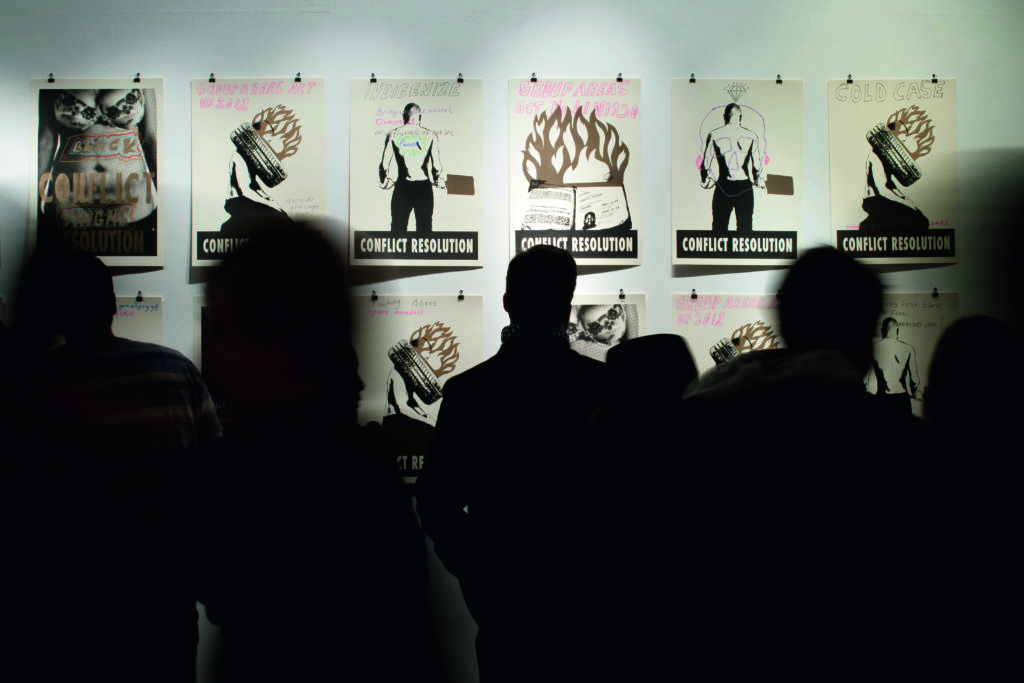Contemporary artist Kudzanai Chiurai is no stranger to controversy. When he drew a picture of Robert Mugabe’s face in flames, after the contested results of the 2008 Zimbabwean elections, he received calls asking him everything from who he was to the meaning and message of his artwork. Chiurai is now in self-imposed exile, he hasn’t been home since 2003, when he was 22.
Now, Chiurai lives in an inner-city loft apartment in east Johannesburg. It’s open-plan, except for the bedroom. His clothes are drying on top of tables and chairs, and vinyl music records are stacked up near the lit fireplace. Art and history books line the shelves.
The softly-spoken 32-year-old is reserved but his work speaks volumes. It caught the eye of British singer Elton John, who bought seven photographs from his Black President collection. But the quiet Chiurai doesn’t seem fazed by the hype that surrounded the purchase.
“It is cool. It’s not like I’ll ever meet Elton John. It’s nice that he bought photographs, but it’s nice that some of my friends bought my posters and have been collecting posters that I’ve made,” says Chiurai.
He was thrilled with the invitation to exhibit at the world-famous documenta exhibition in Germany last year.
“It’s an amazing invitation,” says Chiurai.
This was the 13th exhibition since 1955. It only takes place every five years and a mere 100 artists are invited from around the world. Chiurai was invited along with South Africa’s most celebrated artist William Kentridge and Zanele Muholi, a photographer and visual activist.

Artist Kudzanai Chiurai
“It’s huge… If you show at documenta you’re made as an artist,” says Londi Nzimande-Modiko from the Goodman Gallery in Johannesburg.
Chiurai uses different media like posters, sculptures, short films, drawing and paintings in his work.
His latest work, Conflict Resolution, was shown at documenta as well as in Johannesburg. It was a collection that was easier to admire than to describe. It contained posters of his own identification document, another of a half-naked woman wearing nothing but her bra, and another of a log with Chiurai’s own face embedded in it with five machetes wedged into it. Yet another is a poster of him with a flaming tyre around his neck.
His supporters are twenty-somethings; you can spot them at the arty Thesis Social Jam sessions on Sunday afternoons or at exhibitions, music festivals and fashion shows. They wear clothes that your grandmother used to wear paired with anything from Dr. Martens boots to high heels. The men wear fedoras and many of the women have the sides of their heads shaved; there are turbans and pierced noses everywhere in a vibrant crowd that prefers to call the artist “Kudzi”.
It has been a long road for the first black student to graduate with a Bachelor of Fine Arts at the University of Pretoria. His love for art stemmed from primary school, and now he makes a living from it. His cheapest work sold was R200 ($20) and the most expensive went for R200,000 ($20,000).
“It’s sustainable if you work with a good gallery. There is a sense of independence within all institutions. The relationship between [you] and the broker you work with is not always a perfect relationship. We are all sort of part of some institution whether we like it or not,” says Chiurai.
Chiurai is very confident when he talks about his work. His latest achievement is having his short film Iyeza, an allegory of the Last Supper depicting the establishment of a new nation-state, exploring the African condition by juxtaposing the past and the present of a continent in the grip of violent civil wars. It was selected for the 2013 Sundance Film Festival.
Multimedia is the name of the game and Chiurai is playing it. His previous exhibition, State of the Nation—of which Iyeza was part—received a lot attention. It referenced “child soldiers, African liberation movements, and civil wars. He tracks the similarities in the societal, political and ideological fabric of states in tumultuous times of transition,” according to the Goodman Gallery.
Aside from multimedia, Chiurai is always looking for a different way to tell stories. His first exhibition had a twist to it. He used multimedia and the viewing public.
“I made a couple of short films that I projected onto screens and I made four drawings and then I left them in people’s apartments… so they completed them. Then I collected all of them, [and] then the people who lived in those apartments came to the exhibition… It was fun and interesting.”
“I was never trained in making film or photography… they were kind of like the leading mediums that grab our attention and it’s always interesting, how you can use them,” he says.
Soon he’ll be taking part in an exhibition that will tour the United States and Europe and end in Harare in 2016. So, it seems Chiurai’s art will be making noise in his mother country once again. It will be interesting to see what the authorities will think this time. FL
